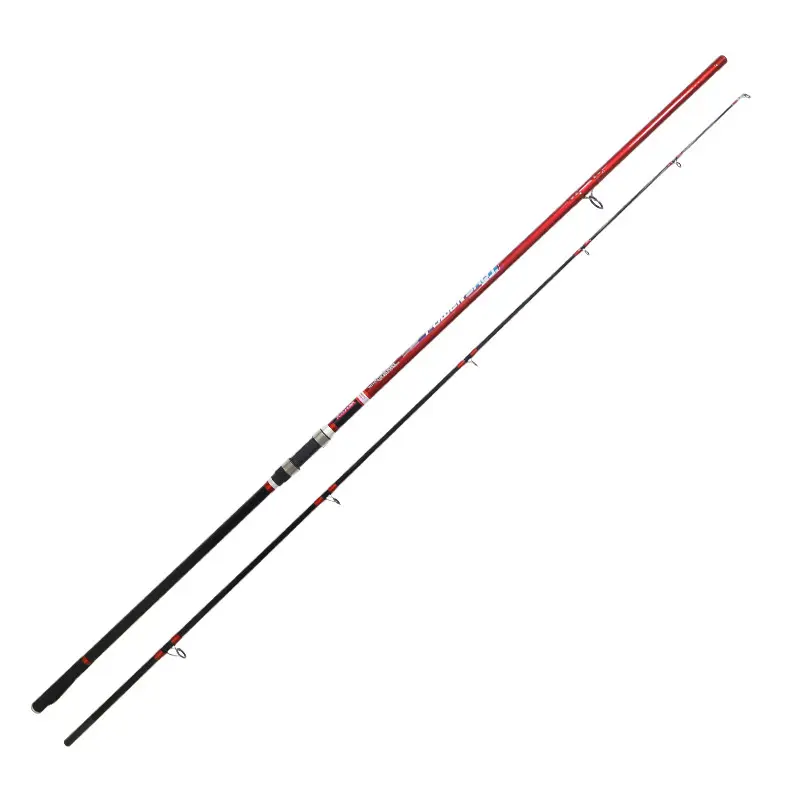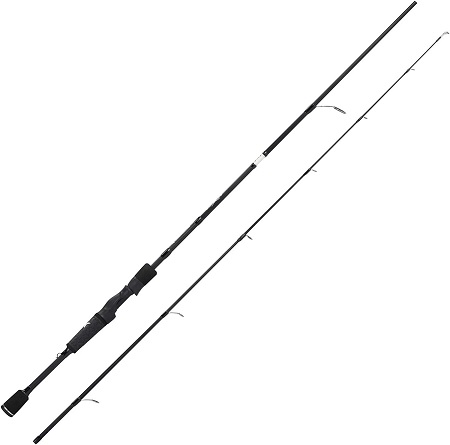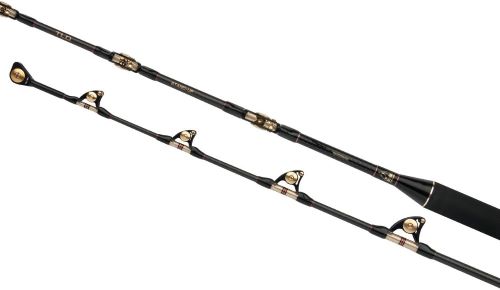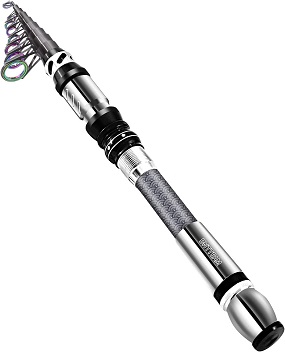
There are many different types of fishing rods, each designed for a specific type of fishing. In addition to these common types listed below, there are many other specialised rods designed for specific types of fishing, such as jigging lures, deep sea, and bass fishing.
When choosing a fishing rod, it is important to consider the type of fishing you will be doing, the size and type of fish you are targeting, and the weight of the lure or bait you will be using. It is also important to consider your budget. They can range in price from a few dollars to several hundred dollars.
- Spinning Rods: Are versatile and popular among anglers. They feature a reel seat positioned underneath the rod and large line guides. They work well for casting light lures and baits and are suitable for various freshwater and saltwater fishing applications.
- Baitcasting Rods: Are designed to work with baitcasting reels, which are mounted on top of the rod. The guides are smaller and face upward to guide the line properly. Baitcasters are commonly used for freshwater fishing, particularly when targeting larger fish species or when precision casting is required.
- Boat Rods: Are designed for fishing from boats, whether it’s a small fishing boat, kayak, or larger offshore vessel. They are generally shorter and sturdier to provide the necessary leverage when fighting fish from a seated or standing position. They come in various styles, including trolling rods for dragging lures or baits behind a moving boat and jigging rods for vertical fishing techniques.
- Surf Rods: Are long, sturdy, designed for casting baits and lures from the shoreline into the surf. They typically range from 9 to 15 feet in length and feature extended handles for two-handed casting. They have the power to handle heavy lines and weights required to cast over long distances.
- Telescopic Rods: Are collapsible rods that can be extended or retracted for easy transport and storage. They are available in various sizes and actions and can be found in spinning, casting, or fly rod configurations. They are convenient for anglers who frequently travel or hike to their fishing spots.
- Trolling Rods: Are intended for trolling, a fishing technique where baits or lures are dragged behind a moving boat. They are typically shorter and thicker than other rods, built to handle heavy lines and withstand the stress of trolling. They often have roller guides to minimise friction from the line.
- Ice Fishing Rods: Are specially designed for fishing through holes drilled in ice. They are short, usually between 18 to 36 inches, to provide better control and sensitivity in the confined space. They often have small reel seats or integrated reel designs.
- Fly Rods: Are used in fly fishing, where the weight of the line carries the lightweight fly to the target. They are long and flexible, usually between 7 to 10 feet, and designed to cast delicate flies accurately. They are classified by weight, ranging from 1 to 15 or more, depending on the species being pursued.
These are just a few examples of fishing rod types, and there are variations and specialised options for specific fishing styles and target species within each category. Choosing the right one depends on the fishing technique, target fish, and the angler’s preferences.
Spinning Rods

The spinning rod, a trusty companion for many anglers. This versatile fishing rod is a favourite among fishing enthusiasts worldwide. It’s designed with a reel seat positioned underneath the rod and features larger line guides compared to other rod types. The beauty of a spinning rod lies in its ability to handle a wide range of fishing situations.
One of its advantages is the ease of use, making it a popular choice for beginners and experienced anglers alike. It excels in casting light lures and baits with precision and accuracy. Whether you’re targeting bass, mullet, mackerel, or even larger saltwater species, this type has got you covered.
Their design allows for a versatile casting technique. You can cast your bait or lure by releasing the line with your finger while holding the rod. This gives you excellent control over your cast and makes it easier to achieve accurate and long-distance throws. It’s also great for presenting delicate presentations or working with live bait.
Another benefit is its versatility across different fishing environments. You can use it in freshwater settings like lakes, rivers, and ponds, as well as in saltwater environments such as bays and estuaries. Whether you’re chasing trout in a mountain stream or battling feisty redfish along the coast, the spinning rod is up to the task.
When it comes to choosing one, you’ll find a variety of options based on factors like length, power, and action. Longer versions provide greater casting distance, while the shorter ones offer more control and manoeuvrability. Power refers to the rod’s strength, ranging from ultralight to heavy, and determines the size of fish it can handle. The action describes its flexibility, with options like fast, medium, or slow, affecting how the rod bends and responds to fish strikes.
Pair it with a spinning reel, and you’ve got yourself a well-balanced setup. The spinning reel hangs below the rod and features a bail system that allows the line to be cast and retrieved smoothly. This combination offers excellent versatility and ease of use for both beginners and seasoned anglers.
So, whether you’re casting for bass in a serene lake or testing your skills in saltwater fishing, the spinning rod is a reliable and adaptable choice. Its user-friendly design, casting versatility, and suitability for various fishing environments make it a go-to option for many anglers seeking an enjoyable and successful fishing experience.
The Best Spinning Fishing Rods Reviewed
Baitcasting Rods
Baitcasting rods, are a popular choice among anglers who want precise control and accuracy when casting their bait or lures. These are designed to be used with baitcasting reels, which sit on top of the rod and have a spool that rotates during casting.
They typically feature a trigger grip, which provides a comfortable and secure hold while casting and reeling in fish. The grip is positioned below the reel seat, allowing anglers to have a firm grasp and better control over the rod. This design also helps in leveraging its power while fighting a fish.
One distinct feature of bait casters is the presence of smaller line guides positioned closer to the rod blank. These guides are designed to guide the line smoothly and efficiently, minimising friction and allowing for longer and more accurate casts. The smaller guides are necessary because baitcasting reels typically have the line coming off the top of the spool, unlike spinning reels where the line comes off the bottom.
They come in a variety of lengths and actions to suit different fishing scenarios and target species. Shorter options provide better accuracy and control in close-quarters fishing, while longer versions excel in situations that require longer casts. The action refers to its flexibility and responsiveness, ranging from fast action (bending mainly at the tip) to medium or slow action (bending throughout its length). The choice of action depends on the fishing technique and the type of fish being pursued.
They are versatile and can be used for various freshwater fishing applications, including bass fishing, pike fishing, and walleye fishing. They can also handle heavier line and lures, making them suitable for certain saltwater fishing situations.
Using a bait caster requires a bit of practice, as it involves thumbing the spool to control the line during the cast and prevent backlash (tangled line on the spool). Once mastered, however, anglers can achieve accurate and controlled casts, allowing them to precisely place their bait or lure in the desired location.
Baitcasting rods are a great choice for anglers who value casting accuracy, control, and the ability to handle heavier lines and lures. They offer a level of precision that can be especially beneficial when targeting specific fish species or fishing in tight spots where accuracy is crucial.
Boat Rods

Boat rods are designed specifically for fishing from a vessel, whether it’s a small fishing boat, a kayak, or even a larger offshore vessel. These are built to handle the unique challenges and conditions that come with boat fishing.
They tend to be shorter in length compared to other types, typically ranging from around 5 to 7 feet. This shorter length allows for better manoeuvrability within the confines of a boat and makes it easier to handle the rod while dealing with a fish.
One important feature is their sturdy construction. They are designed to handle heavy lines, heavy weights, and powerful fish. Since boat fishing often involves targeting larger species like tuna, marlin, or even sharks, they need to have the strength and backbone to withstand the fight. They are usually made from strong materials like fibreglass or carbon fibre to provide the necessary durability and power.
They also incorporate specialised guides and reel seats. The guides, or line guides, are typically larger in size and are positioned on the rod to accommodate the thicker lines commonly used in boat fishing. These guides help reduce friction as the line passes through during casting and reeling in.
When it comes to reel seats, they often feature sturdy and corrosion-resistant materials. This is because boat fishing involves exposure to saltwater, which can be harsh on equipment. So, the reel seats are designed to withstand the corrosive effects of saltwater, ensuring long-lasting performance.
Another feature you might find on boat rods is a gimbal butt. A gimbal butt is a reinforced area at the bottom of the rod that allows it to fit securely into a fighting belt or rod holder. This feature helps stabilise the rod and provides additional support when battling large fish.
They are built tough and are ready to handle the challenges of fishing from a boat. They offer the power, strength, and durability needed to tackle big game fish and withstand the demands of saltwater environments. Whether you’re trolling offshore or dropping lines in the shallows, a good boat rod is an essential tool for any angler looking to have a successful fishing adventure at sea.
The Best Boat Fishing Rods Reviewed
Beach Rods
It’s a fantastic tool for casting your line from the shoreline into the crashing waves of the ocean. Picture yourself standing on a sandy beach, waves rolling in, and you, with your surf rod, ready to tackle some saltwater fishing.
They are designed specifically for this purpose. They tend to be long and sturdy, ranging anywhere from 9 to 15 feet in length. The extra length helps you cast your bait or lure farther out into the surf where the big fish like to hang out. With a longer option, you can really launch your line out there, reaching those distant feeding grounds.
Now, they need to be able to handle heavier lines and weights since you’ll be dealing with the force of the waves. They have a good amount of backbone and power to handle the rough conditions. Plus, they often come equipped with larger line guides to allow the heavier line to pass through smoothly.
Another thing you’ll notice about them is their extended handles. These handles give you a better grip and more leverage, which comes in handy when you’re making those long, powerful casts. And since surf fishing often involves two-handed casting, the extended handle allows you to comfortably position both hands for maximum control.
When it comes to reel choice, many surf anglers prefer spinning reels due to their versatility and ease of use. Spinning reels pair nicely with surfcasting rods and provide a good combination of power and smooth line management. However, you can also find them designed for baitcasting reels if that’s your preferred reel type.
Whether you’re targeting bass, cod, whiting, or other popular saltwater species, the surf rod is your trusty companion for casting out into the deep blue. It’s all about finding the right balance of length, power, and action to match your fishing style and the conditions you’ll be facing.
So, grab your surf rod, find a prime spot along the shoreline, and get ready for an exhilarating fishing experience as you battle the waves and reel in your next big catch. Surf fishing is an adventure like no other, and with the right rod in hand, you’ll be ready to tackle the surf with confidence.
Telescopic Rods

Telescopic rods are like the magic wands of the fishing world. Picture this: you’re on a hiking trip or traveling to your favourite fishing spot, and you want to bring along a fishing rod without the hassle of carrying a long, cumbersome rod. That’s where these come to the rescue!
They are pretty cool because they have the ability to collapse and extend, just like a telescope. You can easily collapse them down to a compact size for transport or storage, making them incredibly convenient for anglers on the go. When you’re ready to fish, simply extend it to its full length, and voila! You’re ready to cast your line and reel in those fish.
They are available in various lengths, actions, and materials, catering to different fishing preferences. You can find telescopic spinning, casting, and even fly rods, so you have options no matter what your preferred fishing style may be. They typically come with their own carrying case or protective sleeve, ensuring that they stay safe and secure during your adventures.
They are loved by many anglers who enjoy traveling, hiking, or just want a compact and portable fishing solution. They allow you to explore new fishing spots, hop on a spontaneous fishing excursion, or keep one handy in your backpack for those unexpected fishing opportunities that come your way.
While they may not provide the same level of sensitivity and power as their non-telescopic counterparts, modern versions have come a long way in terms of quality and performance. They’re designed to be durable and reliable, ensuring you can enjoy your fishing experience without any worries.
So, whether you’re planning a fishing trip or want to have a backup rod for spontaneous fishing adventures, a telescopic rod might just be your perfect fishing companion. Its collapsible nature and portability make it a fantastic option for anglers who are always on the move but still want to indulge in their fishing passion.
The Best Telescopic Fishing Rods Reviewed
Trolling Rods
Trolling rods are specifically designed for a fishing technique called trolling, where you slowly pull baits or lures behind a moving boat. These are built to handle the unique demands of this method and are essential tools for anglers who enjoy fishing from boats.
They differ from other types in a few key ways. First, they tend to be shorter and thicker, providing more strength and durability to handle the stresses of trolling. A typical trolling rod can range anywhere from 5 to 8 feet in length, depending on the specific application and target species.
One notable feature is the presence of roller guides. These guides are designed with small rollers that reduce friction and wear on the fishing line as it passes through, allowing for smoother line movement. Since trolling often involves heavier lines and larger lures or baits, the roller guides help prevent line damage and allow for longer, smoother casts.
They also come with robust reel seats and sturdy handles. The reel seats are designed to securely hold trolling reels, which are often larger and more powerful compared to reels used in other fishing techniques. Their handles are typically comfortable and sometimes feature a gimbal at the base, which can be inserted into a fighting belt or rod holder to provide additional leverage when battling larger fish.
These rods are primarily used in saltwater environments, where anglers target species such as salmon, tuna, marlin, or muskellunge. However, they can also be used in freshwater trolling applications, such as targeting walleye or lake trout. Trolling allows anglers to cover a larger area and present their baits or lures at specific depths, increasing their chances of attracting fish.
Whether you’re cruising along the coast or peacefully trolling a serene lake, trolling rods offer the strength, durability, and specialised features needed to make your trolling adventures a success. So, if you’re planning a fishing trip on a boat and want to explore the open waters, one of these will be your trusty companion to help you hook into those prized catches!
Ice Fishing Rods
Ice fishing rods are specialised, designed specifically for the unique conditions of ice fishing. Ice fishing is a popular winter activity that involves fishing through holes drilled into frozen bodies of water, such as lakes or ponds. Its purpose of is to provide anglers with the necessary sensitivity, control, and strength to catch fish in these icy conditions.
One of the defining characteristics is their length. They are typically shorter than regular fishing rods, ranging from 18 to 36 inches in length. The shorter length allows anglers to fish comfortably in the confined space provided by the ice hole. It also provides better control and manoeuvrability while fighting fish and reeling them in.
Ice fishing rods are designed to be highly sensitive. Since fish tend to be less active and bites can be subtle in cold water, sensitivity is crucial for detecting even the slightest nibbles. They are built with materials that maximise sensitivity, such as graphite or fibreglass. its sensitive tip allows anglers to feel the movements and actions of the fish, enabling them to react quickly and set the hook.
To withstand the harsh conditions of ice fishing, these rods are often built with extra durability. They are constructed to handle the low temperatures, occasional impacts against the hard ice, and the added pressure of reeling in fish from below the frozen surface. They may have additional reinforcements and sturdy guides to prevent line freeze-up and handle heavy lines.
The reel system used with them is often simple and compact. Many of them feature small and lightweight spinning reels or inline reels. Spinning reels are popular due to their ease of use and versatility, while inline reels provide a more direct connection between the rod and the line, enhancing sensitivity.
The rods are commonly paired with specialised lines known as “tip-ups” or “tilts.” These lines are set up with a mechanism that signals when a fish takes the bait. When a fish bites, a flag or indicator is raised, alerting the angler to the potential catch. Tip-ups are often used in conjunction with them to increase the chances of success.
Anglers also have the option to choose between different actions and powers, depending on their target species and fishing technique. Lighter options with fast or medium-fast actions are ideal for panfish, while the heavier ones with medium to medium-heavy power are suitable for larger fish.
They are specialised tools designed to meet the unique demands of fishing in frozen waters. With their shorter length, enhanced sensitivity, durability, and specialised reel systems, they allow anglers to enjoy the excitement of ice fishing and increase their chances of success even in the coldest winter conditions.
Fly Rods
A fly rod is a specialised type, designed for fly fishing, a unique angling technique that focuses on casting lightweight artificial flies to entice fish. Fly fishing is often regarded as an elegant and precise form of fishing, requiring skill and finesse.
They are typically longer and more flexible compared to other types of fishing rods. They range in length from about 7 to 10 feet, although longer and shorter models are available for specific purposes. Its length allows for longer and more accurate casts, enabling the angler to present the fly delicately and naturally to the fish.
The construction consists of several components. The primary material used for the rod blank is usually graphite, although some of them may feature fibreglass or a combination of materials. Graphite options are lightweight, strong, and offer excellent sensitivity, allowing anglers to detect subtle strikes from fish.
They are rated by a weight classification system, denoted as a number from 1 to 15 or more. This rating indicates the weight of the fly line the rod is designed to cast effectively. Lighter weight rods (1-4) are suitable for small fish and delicate presentations, while heavier weight rods (5-15+) are used for larger fish species and casting heavier flies or in challenging conditions.
The action refers to its flex and how it responds when force is applied. There are three primary action types: slow, medium, and fast. Slow action options flex throughout their length, providing a gentle and relaxed casting stroke, suitable for short-range and precise presentations.
Medium action flex more towards the middle, offering a balance between delicacy and power. Fast action have less flex and provide increased power and distance for long casts and windy conditions.
They are designed to work in harmony with a fly reel and fly line. The fly line is the weight-forward line that is cast using the rod. The energy generated by the casting stroke is transferred through the rod to the line, propelling the fly towards the target. The reel is primarily used to store the line and assist in fighting and landing fish.
They are versatile and can be used in various freshwater and saltwater environments. They are commonly employed to target species like trout, salmon, bass, pike, tarpon, bonefish, and many others. Different weights and configurations cater to specific fishing scenarios and fish species.
A fly rod is a specialised tool designed for fly fishing, known for its longer length, flexibility, and precise casting capabilities. It allows anglers to present lightweight artificial flies delicately and accurately, making it a favoured choice among those seeking the artistry and challenge of fly fishing.
In Summary
Fishing rods come in a wide variety of types, each designed to cater to specific fishing techniques, target species, and environmental conditions. The most common types include spinning, baitcasting, fly, surf, telescopic, ice fishing, and boat rods. Each option serves different purposes and offer unique features to enhance fishing experiences.
Whether you’re casting from the shore, trolling from a boat, fly fishing in a river, or ice fishing on a frozen lake, there’s a specialised rod available to meet your needs. Factors such as length, action, material, and reel compatibility should be considered when selecting the right one.
By understanding the various types available and their intended applications, anglers can make informed choices and maximise their chances of success on the water. Remember to match your rod to the fishing technique, target species, and the environment you’ll be fishing in. With the right fishing rod in hand, you can enjoy the thrill of angling and increase your chances of landing that prized catch.
